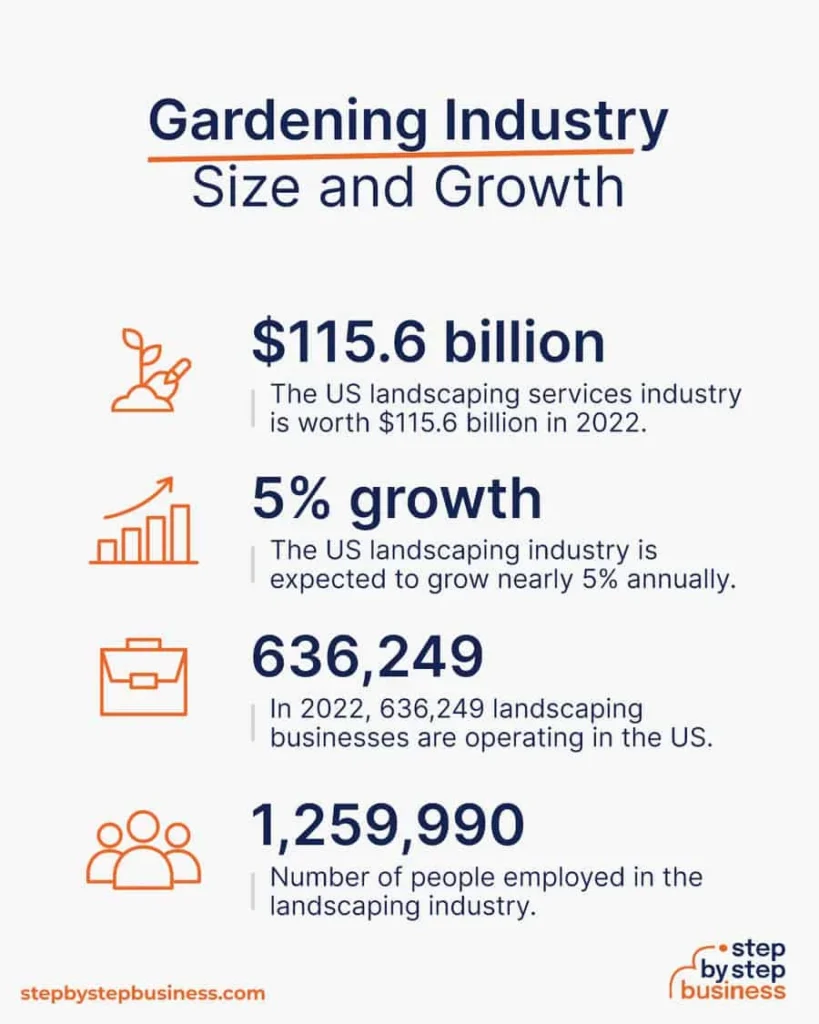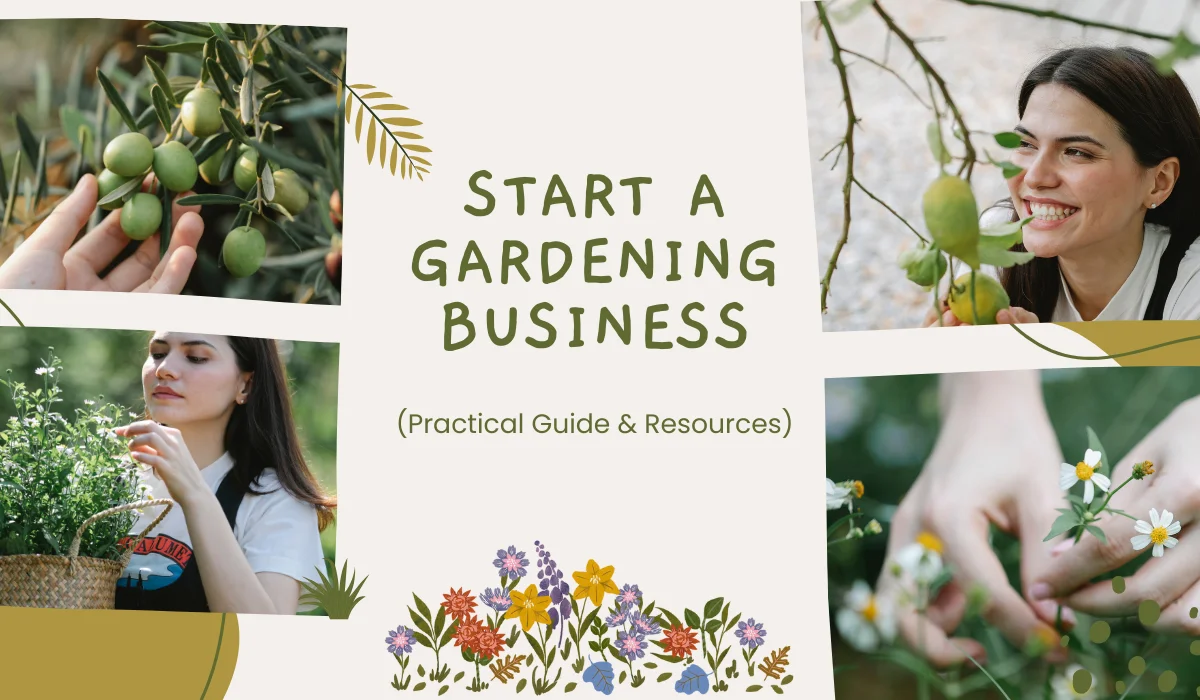So, you’ve got a green thumb and a passion for plants, and you’re thinking about turning that into a profitable venture. You’re not alone. The gardening industry is blooming, and there’s room for more entrepreneurs to dig in. But before you start planting the seeds of your future empire, you need to know the ins and outs of how to start a gardening business.
In this comprehensive guide, we’ll walk you through the steps to start a profitable gardening business. From assessing your gardening business start-up costs to understanding the tools needed to start a gardening business, we’ve got you covered. Let’s get started!
Gardening Industry Size and Growth
Please check the infographic below for the size and growth of the gardening industry in the United States.

10 Proven Steps to Start a Gardening Business in 2024:
Step 1: Conduct Market Research
Know Your Audience: First things first, you need to understand your target market. Are you focusing on residential or commercial clients? What types of services are in demand in your area—landscaping, garden maintenance, or perhaps specialized organic gardening? Conduct surveys, analyze competitors, and identify gaps in the market.
Gardening Business Profitability: Wondering if a gardening venture can be profitable? The answer is intrinsically tied to the depth and quality of your market research. The average rate for gardening services hovers around $45 an hour. This suggests that running a gardening business can be a profitable endeavor, especially when managed effectively.
Moreover, if there’s a high demand for gardening services and limited competition in your area, chances are you’ll reap a healthy profit. On the other hand, if the local market is saturated, you’ll need to find a unique selling proposition to stand out.
Step 2: Create a Business Plan
The Blueprint of Success: A robust business plan is the cornerstone of any successful gardening venture. It outlines your mission, vision, target market, and competitive landscape, while also detailing financial projections and marketing strategies. This invaluable blueprint not only guides your operations but also entices potential investors.
Gardening Business Start-up Costs: In your business plan, make sure to detail your gardening business start-up costs. This should include everything from purchasing equipment and tools needed to start a gardening business to marketing expenses and operational costs. Having a clear financial plan will help you navigate the initial stages of your business effectively.
| Investment Required | $3,000 – $8,000 |
| Revenue Potential | $80,000 – $400,000 per year |
| Profit Potential | $60,000 – $120,000 per year |
| Time to Establish | 1 to 3 Months |
Step 3: Legal Formalities

Choose the Right Business Structure: Whether you opt for a sole proprietorship, partnership, or LLC, your choice of business structure will have implications on taxes, liability, and other factors. For a well-informed decision, it’s imperative to consult with a legal advisor.
Here are some pros and cons of these business structures:
Sole Proprietorship
- Pros: Simple to set up, complete control over the business, straightforward tax filing.
- Cons: Unlimited personal liability, difficult to raise capital.
Partnership
- Pros: Easy to form, shared responsibility, profits pass through to individual tax returns.
- Cons: Unlimited personal liability for each partner, potential for conflicts between partners.
Limited Liability Company (LLC)
- Pros: Limited personal liability, flexibility in management and profit distribution, tax benefits.
- Cons: More complex to set up, subject to self-employment taxes, and state-specific regulations.
Register Your Business: Once you’ve chosen a business structure, it’s time to register your business name and acquire the necessary permits and licenses. This step is crucial for operating legally and building credibility.
Step 4: Secure Financing
Explore Funding Options: You’ve calculated your start-up costs; now, you need the capital to launch. Consider various funding options such as personal savings, bank loans, or even crowdfunding. Every option carries its own benefits and limitations, so make an informed selection.
Manage Your Finances: Once you secure funding, set up a business bank account and accounting system. Keeping your personal and business finances separate is essential for accurate bookkeeping and tax reporting.
Step 5: Choose Your Tools Wisely

Tools Needed to Start a Gardening Business: The right tools can make or break your gardening business. From basic hand tools like spades and pruners to more specialized equipment like lawnmowers and irrigation systems, invest in high-quality, durable tools that will stand the test of time.
Here’s a list of essential tools you’ll likely need:
Hand Tools
- Pruners (Hand Shears) – For cutting small branches and stems.
- Trowel – For planting and transplanting small plants.
- Weeder – To remove weeds from the soil.
- Gloves – To protect your hands while working.
- Hand Rake – For smoothing soil and gathering debris.
- Spade – For digging and transplanting.
- Hoe – For weeding and breaking up soil.
- Cultivator – To aerate and prepare soil.
Power Tools
- Lawn Mower – For cutting grass.
- String Trimmer (Weed Eater) – For trimming edges and hard-to-reach areas.
- Hedge Trimmer – For shaping and trimming hedges and shrubs.
- Leaf Blower – For clearing leaves and debris.
- Chainsaw – For cutting larger branches and trees (if applicable).
- Tiller – For breaking up and preparing larger areas of soil.
Watering Equipment
- Hose with Adjustable Nozzle – For watering plants.
- Watering Can – For more precise watering.
- Sprinkler System – For automated watering (optional).
Safety Gear
- Safety Glasses – To protect your eyes.
- Ear Protection – When using loud power tools.
- Boots – For foot protection and better grip.
- Knee Pads – For tasks that require kneeling.
Miscellaneous
- Wheelbarrow – For transporting soil, compost, or plants.
- Garden Twine – For staking and training plants.
- Measuring Tape – For accurate spacing between plants.
- Plant Labels – To identify different plants.
- Fertilizer Spreader – For even distribution of fertilizers.
Business Tools
- Invoice and Billing Software – For client management.
- Vehicle – For transporting tools and plants.
- Smartphone or Tablet – For scheduling, GPS, and client communication.
Inventory Management: Keep track of your tools and supplies. Implement an inventory management system to ensure you’re well-stocked and prepared for any job that comes your way.
Step 6: Build Your Brand
Create a Strong Identity: Your brand is more than just a logo; it’s the impression you leave on your clients. Work on creating a strong brand identity that reflects the quality and reliability of your services.
Marketing Strategies: Utilize both online and offline marketing strategies to reach your target audience. From social media advertising to flyers and business cards, diversify your marketing efforts for maximum impact.
To effectively market your gardening business and attract customers, follow these steps:
- Register Your Domain and Launch Your Website: Having a professional website lends credibility to your gardening business. In today’s digital age, consumers often look online before making a purchasing decision. A well-designed, informative website can serve as your virtual storefront, making a strong first impression on potential customers. With proper search engine optimization (SEO), your website can rank higher in search results, making it easier for customers to find you
- List your gardening business on local directory websites: You must list your business on sites like Yelp, Thumbtack, Angi, Bark, Airtasker, MeetAGardener, WorkStream, TaskRabbit, etc. New customers will find your business on these sites and you will get quality leads.
- Create and Verify Your Google Business Profile: A Google Business profile is essential for local search. When someone in your area searches for gardening services, your business can appear in the local search results, complete with your location, hours of operation, and customer reviews. This increases the likelihood of local customers finding and choosing your business. You can also interact with customers by responding to reviews, which shows that you value customer feedback and are committed to providing excellent service.
- Also, Create Pinterest and Facebook Profiles: Social media platforms like Pinterest and Facebook allow you to reach a broader audience. Pinterest is particularly effective for a gardening business, as it’s a visual platform where you can showcase your work, share gardening tips, and even post DIY garden projects. This can attract users who are interested in gardening and are likely to require professional services. Running targeted ads can help you reach potential customers in your area. You can also join local community groups to offer expert advice, thereby establishing yourself as an authority in the field and attracting more customers.
Step 7: Set Your Pricing
Competitive Pricing: Pricing is a critical aspect of your business. Research what your competitors are charging and set your prices competitively. It’s crucial to remember that you’re not simply selling a service; you’re delivering an experience that sets you apart.
Offer Packages: Consider offering package deals or seasonal discounts to attract more clients. This not only boosts sales but also encourages customer loyalty.
Step 8: Hire Staff

Choose the Right Team: As your business grows, you’ll need to hire staff. Look for individuals who are not only skilled but also share your passion for gardening. A strong team can significantly impact your business’s success.
Training and Development: Prioritize investment in training programs to bolster your team’s proficiency. A skilled staff translates to increased efficiency, effectiveness, and a more customer-centric approach.
Step 9: Launch Your Business
Soft Launch: Before going all out, consider a soft launch. Offer your services to friends and family at discounted rates to test the waters and gather feedback.
Grand Opening: Once you’re confident in your service quality and operational efficiency, go ahead with a grand opening. Use this opportunity to showcase your services and attract potential clients.
Step 10: Monitor and Scale
Keep Tabs on Performance: Regularly monitor key performance indicators like customer satisfaction, revenue, and growth. Use this data to make informed decisions and improve your services. You can use free tools like Google Analytics, Google Search Console, Google Business Profile, Hubspot (CRM), and more.
Scale Your Business: Once you’ve established a solid customer base and steady revenue stream, think about scaling. Whether it’s expanding your service offerings or entering new markets, scaling is the ultimate goal for long-term success.
Conclusion
Starting a gardening business is more than just having a love for plants; it’s about planting the seeds of entrepreneurship and nurturing them to grow. By following these 10 steps, you’re well on your way to cultivating a successful, profitable gardening business.





